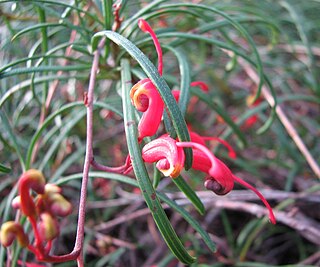
Grevillea nudiflora is a species of flowering plant in the family Proteaceae and is endemic to the south coast of Western Australia. It is a prostrate to low, spreading shrub, usually with linear leaves, and with small groups of red and yellow flowers often close to the ground on long flowering stems.

Grevillea obtusifolia, commonly known as obtuse leaved grevillea, is a species of flowering plant in the family Proteaceae and is endemic to the south-west of Western Australia. It is a spreading to dense, prostrate shrub with oblong to narrowly elliptic leaves and clusters of eight to twelve, pink or red flowers.

Pimelea alpina, the alpine rice-flower, is a species of flowering plant in the family Thymelaeaceae and is endemic to south-eastern continental Australia. It is an erect, prostrate or spreading shrub or undershrub with narrowly elliptic leaves crowded at the ends of branches and heads of pinkish red or white flowers.

Cryptocarya bidwillii, commonly known as yellow laurel, is a species of flowering plant in the laurel family and is endemic to eastern Australia. Its leaves are lance-shaped to elliptic, the flowers creamy-white and tube-shaped, and the fruit an elliptic black drupe.

Pomaderris intermedia, commonly known as lemon dogwood, is a species of flowering plant in the family Rhamnaceae and is endemic to south-eastern Australia. It is a shrub with hairy stems, elliptic to egg-shaped leaves, and clusters of yellow flowers.

Baeckea brevifolia is a species of flowering plant in the family Myrtaceae and is endemic to south-eastern New South Wales. It is a shrub with narrow egg-shaped to oblong leaves and white to pink flowers with nine to fifteen stamens.
Grevillea capitellata is a species of flowering plant in the family Proteaceae and is endemic to the Illawarra region of New South Wales. It is a low, dense mounded or prostrate shrub with narrowly elliptic to oblong leaves, and dull, deep crimson to dark maroon flowers.

Acacia anceps, commonly known as Port Lincoln wattle or the two edged wattle, is a species of flowering plant in the family Fabaceae and is endemic to coastal areas of south-western Australia. It is a bushy, spreading shrub with glabrous branchlets angled at the ends, elliptic to lance-shaped phyllodes with the narrower end towards the base, spherical heads of 50 to 130 golden-yellow flowers, and narrowly oblong pods up to 60 mm (2.4 in) long.

Calytrix asperula, commonly known as brush starflower, is a species of flowering plant in the myrtle family Myrtaceae and is endemic to the south of Western Australia. It is a mostly glabrous shrub with linear to narrowly elliptic leaves and cream-coloured to yellow flowers with 40 to 60 yellow stamens in several rows.

Calytrix exstipulata, commonly known as turkey bush, Kimberley heather, heather bush or pink fringe-myrtle, is a species of flowering plant in the myrtle family Myrtaceae and is endemic to northern Australia. It is an erect shrub with narrowly egg-shaped to elliptic leaves and clusters of dark red, pink and white flowers with mainly pink stamens.

Marianthus tenuis is a species of flowering plant in the family Pittosporaceae and is endemic to the southwest of Western Australia. It is a slender, twining shrub with clustered, narrowly elliptic leaves and white flowers tinged with mauve and with darker spots on three of the five petals.

Leptospermum myrtifolium, commonly known as the myrtle tea-tree or grey tea-tree, is a species of shrub that is endemic to south eastern Australia. It has broad egg-shaped to elliptical leaves, white flowers usually borne singly on short side shoots, and fruit that remains on the plant until it dies.

Philotheca myoporoides subsp. myoporoides, commonly known as long-leaf wax flower, is a subspecies of flowering plant in the family Rutaceae and is endemic to south-eastern continental Australia. It is a shrub with oblong to elliptic or egg-shaped leaves and white or pink flowers arranged in groups of three to eight in leaf axils.

Pultenaea capitellata, commonly known as hard-head bush-pea, is a species of flowering plant in the family Fabaceae and is endemic to south-eastern continental Australia. It is a sprawling to prostrate shrub with elliptic to broadly egg-shaped leaves, and yellow to orange flowers with a red to purple keel.
Pultenaea villifera is a species of flowering plant in the family Fabaceae and is endemic to two disjunct areas of Australia. It is an erect to prostrate shrub with triangular to linear, egg-shaped to elliptic leaves and yellow and red, pea-like flowers.

Bauera capitata is a species of flowering plant in the family Cunoniaceae and is endemic to coastal eastern Australia. It is a small shrub with trifoliate, usually lobed leaves and sessile, deep pink flowers with twelve to fifteen stamens.
Olearia elaeophila is a species of flowering plant in the family Asteraceae and is endemic to the south-west of Western Australia. It is a small shrub with scattered linear leaves, and white or blue and yellow, daisy-like inflorescences.

Pimelea floribunda is a species of flowering plant in the family Thymelaeaceae and is endemic to the south-west of Western Australia. It is a shrub with narrowly elliptic to egg-shaped leaves arranged in opposite pairs, and drooping, head-like clusters of white or cream-coloured, tube-shaped flowers.

Styphelia angustifolia is a species of flowering plant in the heath family Ericaceae and is endemic to eastern New South Wales. It is an erect shrub with lance-shaped to narrowly egg-shaped leaves and pale green, pendent flowers in summer.

Wilkiea macrophylla, commonly known as large-leaved wilkiea, is a species of flowering plant in the family Monimiaceae, and is endemic to north-eastern Australia. It is a glabrous shrub or small tree with narrowly to broadly elliptic leaves, and male and female flowers on separate plants. Male flowers have 2 pairs of tepals and usually 2 pairs of stamens, and female flowers have 6 or 7 pairs of tepals and 13 to 20 carpels. The fruit is a glossy purplish to olive black drupe.

















